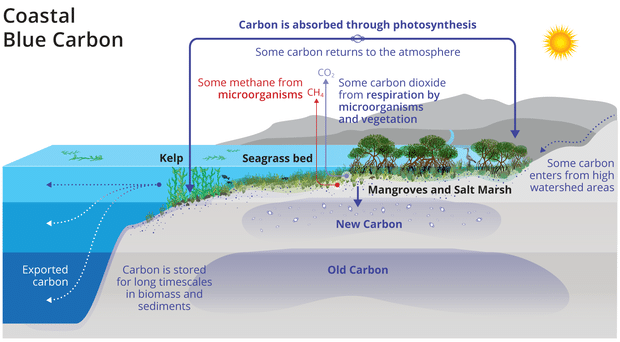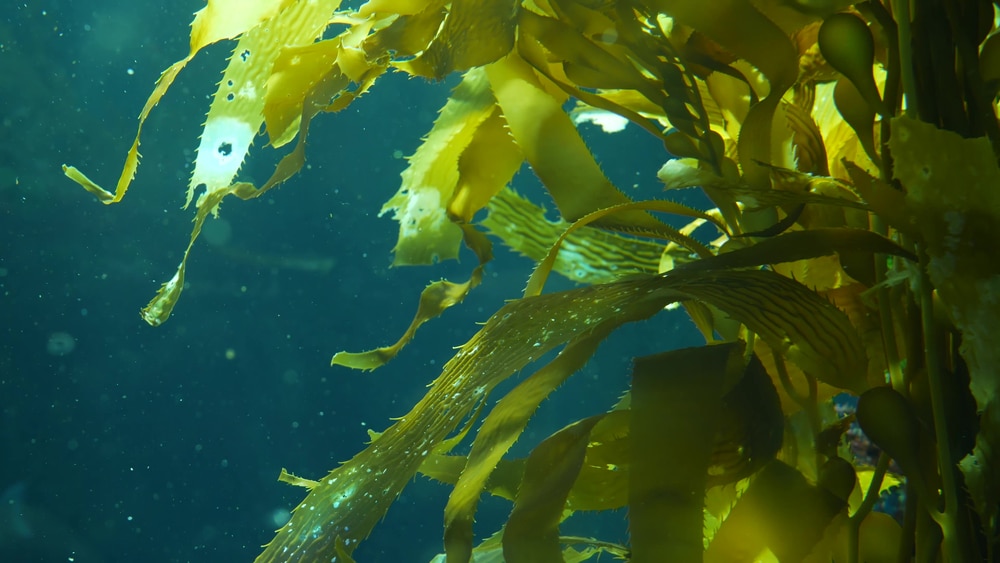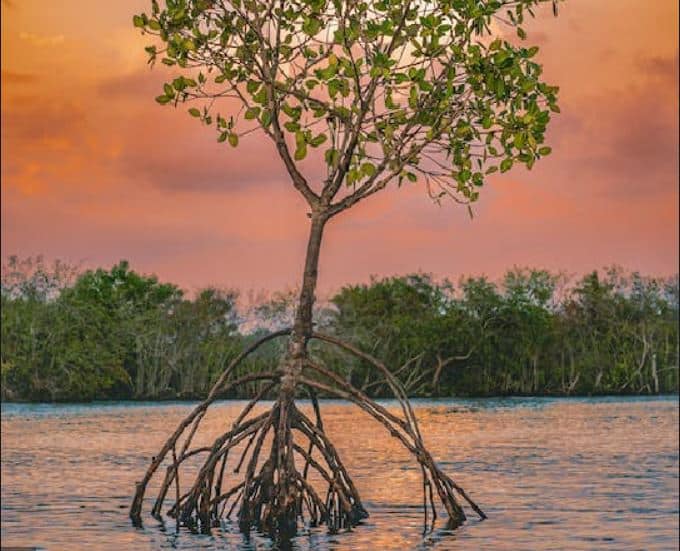Carbon credits from offset projects such as reforestation and direct air capture have become popular, but a new crediting method still in its infancy is quickly gaining attention globally – blue carbon.
The role of marine ecosystems in removing carbon emissions has been in the spotlight lately, and the idea of a market to finance their protection.
Coastal ecosystems such as mangroves, tidal marshes and seagrass meadows can protect coastlines from disasters like storms, rising sea-levels and shoreline erosion. They regulate water quality and provide habitat for fish, ensuring food security and livelihoods for local communities.
But these ecosystems have been gaining more popularity for their role in fighting climate change by capturing and storing carbon from the atmosphere. Thus, giving them new fame as “blue carbon” ecosystems along with the credits they create – blue carbon credits.
As this fame is gaining momentum, many are asking what is a blue carbon credit? What are the possible ways to invest in it and how to buy it? This guide will help you learn everything you need to know about blue carbon credits and what to do to join this growing market.
What are Blue Carbon Credits?
Coastal habitats cover 2% of the ocean’s surface but store 50% of the carbon in their sediment. They’re a 75-gigaton carbon sink, which is equal to 8 years of carbon emissions from fossil fuel.
The bad news is that these ecosystems are under threat – between 25% and 50% of marine habitats have gone in the past 100 years, according to the UN panel.
So, unlocking investments for this field through blue carbon can be the solution to saving these ecosystems.
Blue carbon is a new concept which refers to carbon that’s stored in marine ecosystems mentioned earlier. Those ecosystems are providing a couple of ecological services like shoreline protection and water quality maintenance.

More remarkably, blue carbon gains more attention as a potential source of carbon credits as they can capture and store huge amounts of carbon for long periods of time. In fact, research found that coastal wetlands and seagrass beds suck in carbon up to 40x faster than tropical rainforests. This makes them a valuable resource for mitigating climate change.
But as it’s still in its early stage, there are many challenges that have to be fixed before it can be fully integrated into the global carbon market.
Fortunately, as there’s growing interest and momentum around the world to develop blue carbon projects. And many of these organizations continue to develop standards and methodologies to measure and verify the CO2 stored in coastal ecosystems.
How is a blue carbon credit generated?
When an ecosystem like a seagrass meadow is protected or restored, it can capture CO2. If this carbon capture is quantified and verified, it generates blue carbon credits. These credits are tradable on carbon markets for entities wanting to offset their GHG emissions.
The revenue from the sales of blue carbon credits can then help fund the conservation and restoration of those ecosystems.
To ensure that blue carbon credits are verifiable, they must meet established standards for carbon accounting and verification, such as the Verified Carbon Standard or the Gold Standard. The standards help make sure that the credits are indeed real, measurable, and verifiable carbon reductions and the projects that produce them meet the criteria.
So far, the most popular projects are on restoring mangroves around the world. Mangroves have been estimated to prevent ~$65 billion in property damages and lower flood risk to millions of people each year.
Factor in their ecosystem service benefits projected to be at the range of $462 to $798 billion every year, and you get the picture how crucial their role is.
In 2021, Apple and Conservation International partnered to turn 11 thousands acres of mangroves to be the first to have its carbon sequestration potential converted into blue carbon credits verified by Verra.
Conservation International also worked with Procter & Gamble in a project that protected over a hundred thousand acres of mangroves in Palawan, Philippines.
While mangroves are the most common sort of blue carbon projects, other initiatives also exist that produce blue carbon credits. Restoring and protecting marshes, seagrass, and kelp forests are also gaining interests from investors.
Even more emerging is the concept of carbon sinking through seaweeds. Instead of letting the seaweeds decompose on shorelines, carbon sequestration companies take them to the ocean floor to capture carbon.
All these promising carbon sequestration abilities capture both investors and environmentalists. But there’s still a big gap in investment to support blue carbon projects.
An estimate said that only 3% of the total climate investments goes to nature-based solutions and blue carbon efforts receive a small chunk of the funds.
But the nascent sector is starting to get a lot of questions about how to invest in blue carbon projects via the credits they generate. If you have the same query in mind, let’s help you know your options.
How To Invest In Blue Carbon Credits
Blue carbon markets are relatively new compared with terrestrial carbon sequestration markets like tree planting. But they are seen to be a big part of the global demand for carbon credits.
The Taskforce on Scaling Voluntary Carbon Markets (TSVCM) estimated that the carbon credit market will grow 15x its 2020 levels. It can be worth as much as $50bn by 2030.
- In 2021, the value of the voluntary carbon market (VCM) is only $1 billion with some estimates to go up to $1.7bn in 2022.
The percentage of blue carbon credits trading in the VCM remains to be seen. But the trends say that they’re here to stay and grow.
When it comes to investing in blue carbon credits, it might be a bit more challenging than investing in other forms of credits. But for only one reason – the market is quite new and not yet established.
But that means you can’t invest in the market and support its growth.
With that said, here are the three ways on how to invest in blue carbon credits:
1. Investing directly in blue carbon projects
While we can’t tell the exact number of companies developing blue carbon projects, there are many companies and organizations that are currently involved in this field.
Many companies are also interested in investing in these projects as a means to mitigate their carbon footprint and contribute to the conservation of coastal ecosystems. Some big names include Microsoft, Airbnb, and Shell.
There are also many non-profit organizations and government agencies that are taking part in blue carbon conservation and restoration efforts.
Some blue carbon project developers may offer investment opportunities for you. These investments can be in the form of equity or debt financing. And the returns you get can vary depending on the project’s success.
2. Investing in blue carbon funds
If you prefer a more liquid investment opportunity, then you may want to invest in blue carbon funds. Some investment funds are focusing on blue carbon.
This investment scheme can give you exposure to a diversified portfolio of blue carbon projects. Plus, the funds can also give you a more accessible way to invest in blue carbon credits than the first option above.
3. Buying blue carbon credits on the VCM
One last way for you to make your money grow with blue carbon is to purchase the credits on the VCM.
There are now a lot of platforms that allow you to buy carbon credits from blue carbon projects. You can use these credits to offset emissions or you can have them as a form of investment.
But just remember to do your research to ensure that the credits you buy are from legitimate blue carbon projects.
So there you have it. The ways how to put your money into the market and grow it.
A quick reminder though… investing in blue carbon credits has some risks, just like any other investment opportunities out there.
The major risks are natural – erosion, floods, and storms. Other risks may have something to do with regulations when developing and implementing the projects.
So, don’t forget to do your due diligence to know what investment option works best for you.
The same goes if you’re planning to buy blue carbon credits and want to know how.
How To Buy Blue Carbon Credits
One big question you would want to know first is how much a blue carbon credit is worth? Just like other types of carbon credits, a blue carbon credit’s price is influenced by several factors.
Location of the project is one factor. In Asia and Central America, each credit for blue carbon projects costs the range between $13 – $35.
You can also buy blue carbon credits in many ways. Here are your few options, which are basically the same as the ways how to invest in blue carbon projects:
1. Purchase credits on the VCM
Blue carbon credits are traded on the VCM as one among the different types of credits available. Though not all of the companies selling carbon credits may have blue carbon credits in particular.
You will know by visiting their website to see what projects those credits are from.
The voluntary market is rich with different platforms trading blue carbon credits. But then again, see to it that the credits you buy are real and verifiable.
2. Buy through investment funds
You can also get the credits specifically from investment funds or ETFs (exchange-traded funds). These funds also come in different types so pick the one that’s into blue carbon projects.
They offer investors the opportunity to earn returns while also financing the development and deployment of coastal and marine ecosystems. So, if you decide to buy through these funds, you’ll expose yourself to diversified funds with different risks.
Just select the right fund that meets your offsetting needs.
3. Direct investment
Lastly, you can also get the credits through direct investment in the project of your choice. You can buy them either in the form of equity or debt financing. The latter may offer higher returns for investors but they also come with bigger risk.
If you decide to pick this last option, you may need to make sure that the project satisfies the established criteria and standards for blue carbon accounting and verification.
You may also want to consider any co-benefits that the project provides such as local job creation and biodiversity conservation. The important thing is that your purchase aligns with your goals.
Investing In Blue Carbon Credits
If you are interested in investing in blue carbon credits, it would be a great way to have another income stream while supporting the protection of marine ecosystems.
But before you do, here are some things to keep in mind first:
Understanding the market: this means knowing the various types of projects that produce blue carbon credits, the specific type of credits available, and the demand for those credits.
Assessing the investment opportunities: as mentioned earlier, there are many ways to invest in blue carbon credits. Carefully assess each of the options to know which one fits your investment goals and purpose.
Weighing returns vs. risks: though investing in blue carbon credits offer attractive returns, there are also some risks that come with it. As the demand for carbon credits grows in the long run, the value of blue carbon credits may also grow.
Doing your due diligence: before you invest in blue carbon projects or funds, perform a thorough research about it first. Just ensure that the project is capable of achieving the goals it claims it will do.
So, overall, investing in blue carbon credits is a great means to contribute to climate action while getting a chance to earn. These credits are becoming more popular as the projects they support are very capable of keeping carbon away from causing more temperature rise.



